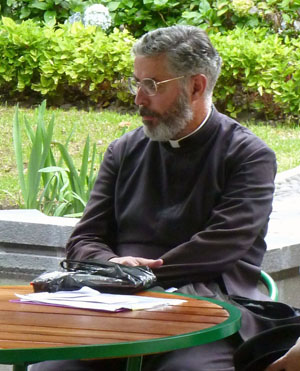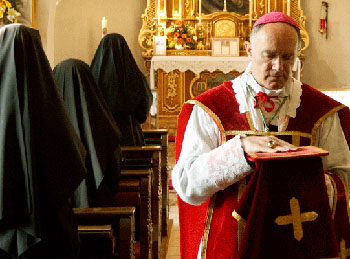From TIA on the Feast of Our Lady of Guadalupe.Link:
Bp. Fellay's New HermeneuticsThe New ‘Hermeneutics’ of Bishop Fellay - Part I A Soft SSPX Walking toward Its ѕυιcιdєFr. Juan Carlos Ortiz
This recent open letter by Fr. Ortiz from Colombia, sent to TIA by a reader, reflects well that the dissatisfaction inside SSPX continues, notwithstanding a temporary interruption in the negotiations between Rome and the leadership of that priestly organization. Today we transcribe the first part of Fr. Ortiz' docuмent to inform our readers about the present state of affairs. Shortly the second part will be available on this page.
Given the length of the original docuмent, we divided it into two parts. The main title and subtitles are ours. The Editor Despite some seemingly reassuring recent discourses, the Society of St Pius X continues to go through the most serious internal crisis, in its complexity and in its seriousness, which it has never known.
This crisis is particularly grave because it derives from serious failings on the part of Bishop Fellay and his two Assistants, in the doctrinal field as well as in the domain of prudence. This is the main cause of the concern of members of the Society.
Some are tempted to believe that because so far there has not been a practical agreement with Rome the danger is over... But let us not conclude so quickly!
Leaning toward compromise & causing an internal crisis Despite the appearances, the superiors of the Society have not retracted their new concept concerning the role of Tradition in the Church and in particular the relationship with the conciliar church. In addition, they are far from having taking any personal responsibility for this internal crisis caused by their imprudent actions.
 Fr. Ortiz: Fellay did not retract and is the architect of the internal crisis
Fr. Ortiz: Fellay did not retract and is the architect of the internal crisisFr. Ortiz: Fellay did not retract and is the architect of the internal crisis
It is worthwhile to look closely at two aspects of this internal crisis in order not to underestimate the negative effects that continue to be produced in the Society and in the ranks of Tradition.
The first aspect concerns the main role which the Society plays in the resistance to the Conciliar Church and the preservation of Catholic Tradition. If the Society falls, the last bastion of Tradition will fall.
The second aspect concerns the grave change made by Menzingen as to the principal role of the Society in the forefront of responding to this crisis of the Church: This new role is clearly in opposition to the one given by Arch. Lefebvre.
However, this change is very subtle and can be difficult to see for some because while they are claiming that they do not want to give up the doctrinal combat, these superiors have made the canonical recognition the essential priority of the Society. Some doctrinal aspects are still in their agenda, but they are placed on the second level. Thus, everything must be "redefined" according to this new priority.
This change betrays in them the same "legalism" which has afflicted all the traditional communities that have rallied to Rome since 1988. Like them, they feel "guilty" because they have been “excluded” by the Official Church and they dream of being "reconciled" at all costs.
We know the "hermeneutics of continuity" of Benedict XVI by which he has conceived a new interpretation of tradition that would integrate the Conciliar Church into the Tradition of the Church.
The authorities of Menzingen, in order to justify their change of position, also have conceived a new "hermeneutics" or "reinterpretation" of the main role of the Society, by which they want to integrate their tradition into the Conciliar Church.
The soft positions of today's SSPX This “hermeneutic” demands that the SSPX authorities make a distorted “re-thinking” of what Archbishop Lefebvre understood as being a priority for the Society; for example, they only quote words he spoke before the break with Rome in 1988, or his more conciliatory words concerning the official authorities of the Church.
 Walking away from the Catholic doctrine to pocket a canonical recognition
Walking away from the Catholic doctrine to pocket a canonical recognition Walking away from the Catholic doctrine to pocket a canonical recognition
Thus, what was formerly vigorously rejected in the Conciliar Church is now "rethought" with a view toward accepting, if not totally, at least "partially" or "under certain conditions”, conciliar ideas.
It should be noted that the authorities of the Society betray this new attitude more by what they do not say in regard to the conciliar authorities, by omission, rather than by direct speech.
Except for a few more firm phrases here and there (to reassure the "harder" line among us), we can see a long-lasting "positive" attitude towards the teachings and the actions of the conciliar authorities, and in particular of Benedict XVI.
A recent example of this “softening “is certainly the boycott by Menzingen of some books deemed "too hard," books written by Bishop Tissier and by Fr. Calderón on the Conciliar Church. Another example would be the recent Symposium of The Angelus, in the United States District, which chose as this year's theme "The Papacy" when we are commemorating the 50th anniversary of the disastrous opening of Vatican II!
The right to denounce a voluntary ѕυιcιdє Some then might ask, for what purpose and by what right should this new direction in the Society be denounced?
I know the Society and its purpose, having been a member priest for 28 years. I deeply love the Society in which I took a commitment for life. I have personally known the Founder, who ordained me, and whose writings and words I have always continued to study. It is because of my love for the Society and by filial piety towards Arch. Lefebvre that I think it is my duty to speak out publicly.
It appears clear to me that for several years there has been a fundamental change, mainly among Bishop Fellay and his two Assistants, concerning the main role of the Society of Saint Pius X in these times of crisis in the Church: to fully preserve the Catholic Tradition by fighting against the enemies of the Church both inside and outside.
The main goal of the Society of Saint Pius X in this crisis of the Church cannot be changed since that goal was clearly established by its Founder in many of his writings, sermons, lectures and actions, especially after 1988. Consequently, to change this purpose on important points would be to depart gravely from its Founder, and thus to expose the Society to commit ѕυιcιdє, by falling into the hands of the modernist Rome, which the Society always fought since its foundation.
Experience shows us that all those who strayed from the line drawn by Arch. Lefebvre eventually finished by betraying the combat for Tradition.
This change in the Society cannot be justified, because in recent years we have not seen in the Conciliar Church any important doctrinal or practical change in the sense of a real return to Tradition by the condemnation of the conciliar errors and reforms.
To be continued
Posted December 12, 2012